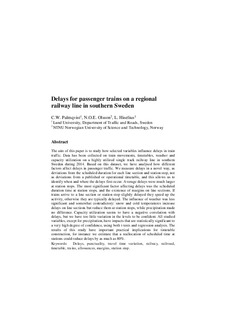| dc.contributor.author | Palmqvist, Carl-William | |
| dc.contributor.author | Olsson, Nils | |
| dc.contributor.author | Hiselius, Lena | |
| dc.date.accessioned | 2017-06-21T07:10:23Z | |
| dc.date.available | 2017-06-21T07:10:23Z | |
| dc.date.created | 2017-06-15T14:48:46Z | |
| dc.date.issued | 2017 | |
| dc.identifier.citation | International Journal on Transport Development and Integration. 2017, 1 (3), 421-431. | nb_NO |
| dc.identifier.issn | 2058-8305 | |
| dc.identifier.uri | http://hdl.handle.net/11250/2446525 | |
| dc.description.abstract | The aim of this article is to study how selected variables influence delays in train traffic. Data has been collected on train movements, timetables, weather and capacity utilization on a highly utilized single-track railway line in southern Sweden during 2014. Based on this dataset, we have analysed how different factors affect delays in passenger traffic. We measure delays in a novel way, as deviations from the scheduled duration for each line section and station stop, not as deviations from a published or operational timetable, and this allows us to identify when and where the delays first occur. Average delays were much larger at station stops. The most significant factor affecting delays was the scheduled duration time at station stops and the existence of margins on line sections. If trains arrive to a line section or station stop slightly delayed they speed up the activity, otherwise they are typically delayed. The influence of weather was less significant and somewhat contradictory: snow and cold temperatures increase delays on line sections but reduce them at station stops, while precipitation made no difference. Capacity utilization seems to have a negative correlation with delays, but we have too little variation in the levels to be confident. All studied variables, except for precipitation, have impacts that are statistically significant to a very high degree of confidence, using both t-tests and regression analysis. The results of this study have important practical implications for timetable construction; for instance we estimate that a reallocation of scheduled time at stations could reduce delays by as much as 80%. | nb_NO |
| dc.language.iso | eng | nb_NO |
| dc.publisher | WIT Press | nb_NO |
| dc.title | Delays for passenger trains on a regional railway line in southern Sweden | nb_NO |
| dc.type | Journal article | nb_NO |
| dc.type | Peer reviewed | nb_NO |
| dc.description.version | submittedVersion | nb_NO |
| dc.source.pagenumber | 421-431 | nb_NO |
| dc.source.volume | 1 | nb_NO |
| dc.source.journal | International Journal on Transport Development and Integration | nb_NO |
| dc.source.issue | 3 | nb_NO |
| dc.identifier.doi | 10.2495/TDI-V1-N3-421-431 | |
| dc.identifier.cristin | 1476442 | |
| dc.description.localcode | This is the authors' manuscript to the article (preprint). | nb_NO |
| cristin.unitcode | 194,64,55,0 | |
| cristin.unitname | Institutt for produksjons- og kvalitetsteknikk | |
| cristin.ispublished | true | |
| cristin.fulltext | preprint | |
| cristin.qualitycode | 1 | |
